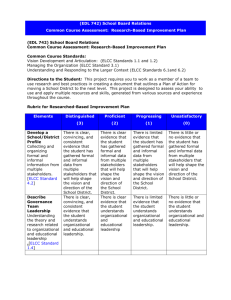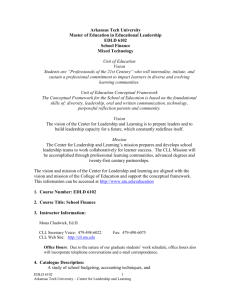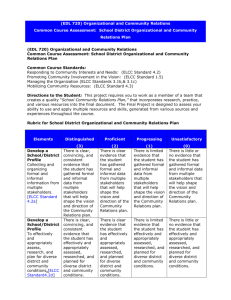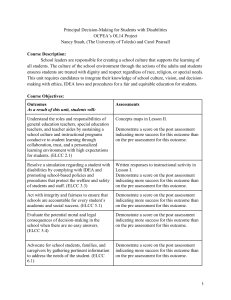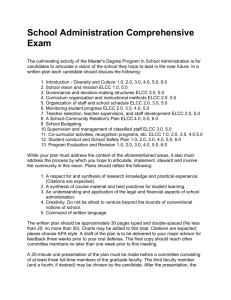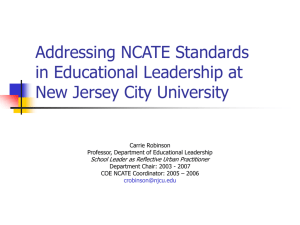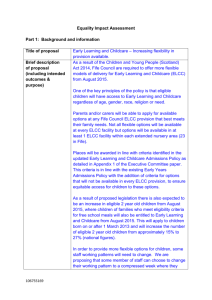EDLD 6352 - Arkansas Tech University
advertisement
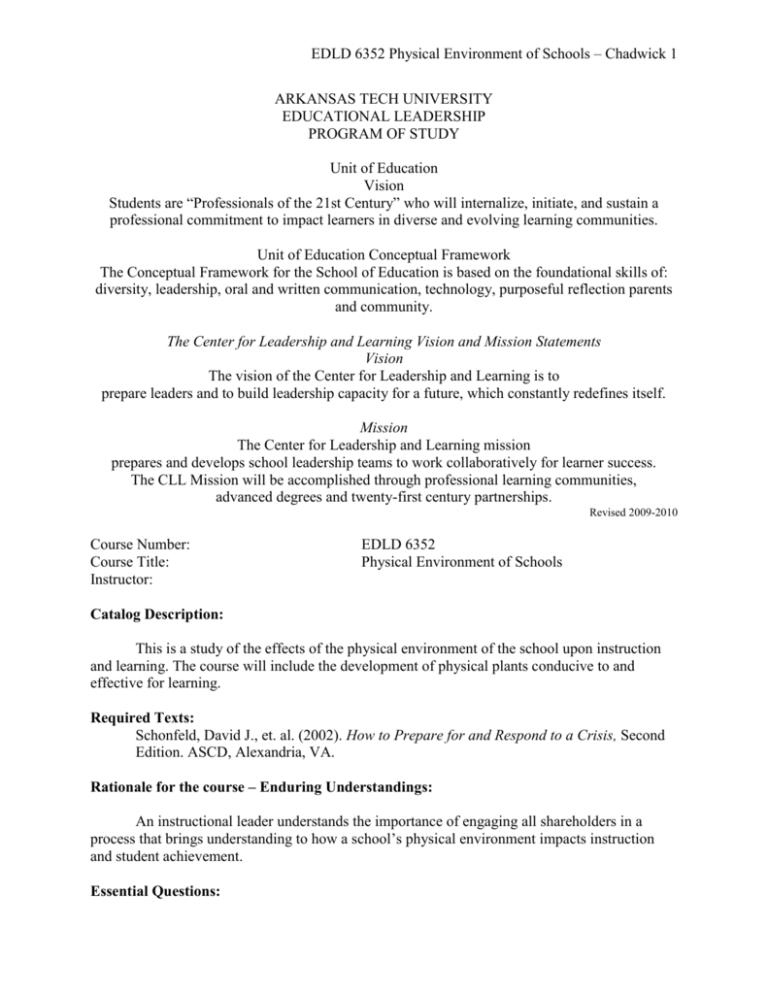
EDLD 6352 Physical Environment of Schools – Chadwick 1 ARKANSAS TECH UNIVERSITY EDUCATIONAL LEADERSHIP PROGRAM OF STUDY Unit of Education Vision Students are “Professionals of the 21st Century” who will internalize, initiate, and sustain a professional commitment to impact learners in diverse and evolving learning communities. Unit of Education Conceptual Framework The Conceptual Framework for the School of Education is based on the foundational skills of: diversity, leadership, oral and written communication, technology, purposeful reflection parents and community. The Center for Leadership and Learning Vision and Mission Statements Vision The vision of the Center for Leadership and Learning is to prepare leaders and to build leadership capacity for a future, which constantly redefines itself. Mission The Center for Leadership and Learning mission prepares and develops school leadership teams to work collaboratively for learner success. The CLL Mission will be accomplished through professional learning communities, advanced degrees and twenty-first century partnerships. Revised 2009-2010 Course Number: Course Title: Instructor: EDLD 6352 Physical Environment of Schools Catalog Description: This is a study of the effects of the physical environment of the school upon instruction and learning. The course will include the development of physical plants conducive to and effective for learning. Required Texts: Schonfeld, David J., et. al. (2002). How to Prepare for and Respond to a Crisis, Second Edition. ASCD, Alexandria, VA. Rationale for the course – Enduring Understandings: An instructional leader understands the importance of engaging all shareholders in a process that brings understanding to how a school’s physical environment impacts instruction and student achievement. Essential Questions: EDLD 6352 Physical Environment of Schools – Chadwick 2 What points should be considered when assessing the physical environment of a school for successful teaching and learning? How has the evolution of educational facilities impacted the teaching and learning processes? How does a safe school promote the social and emotional well-being of students? Why is carrying out a facilities assessment important? What is a crisis plan and how do you implement one? What are the enduring understandings required to undertake such a plan? Is aligning architecture and education important? How does the mission and vision of a school support facilities? Why is designing a facility project with the participation of the school stakeholders and shareholders necessary? Standards: ISLLC Standard One: An education leader promotes the success of every student by facilitating the development, articulation, implementation, and stewardship of a vision of learning that is shared and supported by all stakeholders. ISLLC Standard Three: An education leader promotes the success of every student by ensuring management of the organization, operation, and resources for a safe, efficient, and effective learning environment. ISLLC Standard Six: An education leader promotes the success of all students by understanding, responding to, and influencing the larger political, social, economic, legal, and cultural context. ELCC Standard One: A building-level education leader applies knowledge that promotes the success of every student by collaboratively facilitating the development, articulation, implementation, and stewardship of a shared school vision of learning through the collection and use of data to identify school goals, assess organizational effectiveness and implement school plans to achieve school goals; promotion of continual and sustainable school improvement; and evaluation of school progress and revisions of school plans supported by school-based stakeholders. ELCC Standard Two: A building-level education leader applies knowledge that promotes the success of every student by sustaining a school culture and instructional program conducive to student learning through collaboration, trust, and personalized learning environment with high expectations for students; creating and evaluating a comprehensive, rigorous, and coherent curricular and instructional school program; developing and supervising the instructional and leadership capacity of school staff; and promoting the most effective and appropriate technologies to support teaching and learning within a school environment. ELCC Standard Three: A building-level education leader applies knowledge that promotes the success of every student by ensuring the management of the school organization, operation, and resources through monitoring and evaluating the school management and operational systems; EDLD 6352 Physical Environment of Schools – Chadwick 3 efficiently using human, fiscal, and technological resources in a school environment; promoting and protecting the welfare and safety of school students and staff; developing school capacity for distributed leadership; and ensuring that teacher and organizational time is focused to support high-quality instruction and student learning. ELCC Standard Four: A building-level education leader applies knowledge that promotes the success of every student by collaborating with faculty and community leaders, responding to diverse community interests and needs, and mobilizing community resources on behalf of the school by collecting and analyzing information pertinent to improvement of the school's educational environment; promoting an understanding, appreciation, and use of the diverse cultural, social, and intellectual resources within the school community; building and sustaining positive school relationships with families and caregivers; and cultivating productive school relationships with community partners. ELCC Standard Six: A building level education leader applies knowledge that promotes the success of every student by understanding, responding to, and influencing the larger political, social, economic, legal and cultural context through advocating for school students, families, and caregivers, acting to influence local, district, state and national decisions affecting student learning in a school environment; and anticipating and assessing emerging trends and initiatives in order to adapt school-based leadership strategies. Goals and Objectives: The administrator should be aware of and understand the importance of the current Arkansas Facility Standards from the building standpoint. (ELCC 3.1, 6.2) The administrator remains current about the evolution of school facilities and their impact on current and future instructional methods and student achievement (ELCC 2.2, 6.3) The administrator understands that consistent and continual assessment of the physical environment impacts both current and future planning (ELCC 1.2, 3.2) The administrator understands how to lead a visioning process for the design of all school facility projects in a manner that will include the school community and all stakeholders (ISLLC 1. Functions A., B., C., D., & E.) (ELCC 1.1, 4.1) The administrator remains current on how school facilities will impact the larger political, social, economic, legal, and cultural values throughout the community (ELCC 6.3b) (ELCC 4.1, 4.2) The administrator should be aware of and be able to discuss safety issues in the school as they pertain to the social and emotional well-being of the students, faculty and staff (ISLLC 3. Functions A., B., & C) (ELCC 3.3) The administrator will prepare a building crisis plan designed to accommodate the needs of the building specific student body, faculty, and staff (ISLLC 3. Function C.) (ELCC 3.3) The administrator will build support for a facility project by preparing a memo to the faculty and staff for the purpose of building support and ownership of the project. (1.1, 4.1) EDLD 6352 Physical Environment of Schools – Chadwick 4 The administrator will analyze the current facility issues facing schools and show she/he has the knowledge, skills and dispositions to understand those issues and be able to explain their impact on the community and instructional delivery (ELCC 2.1, 4.1) The administrator will demonstrate an entry-level understanding of how collaboration will bring all shareholders to an understanding about how current state facility mandates affect the local schools (ELCC 4.1, 6.2) The administrator will demonstrate the knowledge, skills, and dispositions needed to engage community and school shareholders as collaborative team members in an overall safe school campaign at the building level – see artifact descriptor (ELCC 3.3, 4.1) Instruction Requirements: Individual reading of required text Group discussions/reporting Fieldtrip Facility assessments Guest speaker summaries and reflections Assessments: Attendance – (W3) Participation and Quizzes – (W2) 2 Article Reviews – (W2) – Can be two of the eight required for the artifact Oral Presentation in class (W4) Artifact – (W5) (Extra Credit) – Download and copy sections of the State Facilities Manual that you find useful as an educational leader. Artifact Descriptor: Scenerio: As an educational leader you have been asked by your superintendent to assess your school building for securing and maintaining a safe, healthy environment for all students and staff. You will be asked to make a presentation to the class (the superintendent, board and other interested community shareholders) with your findings and recommendations. You may use a Powerpoint, brochure, or other method of presentation from 6—8 minutes. Your presentation should show evidence that you as an educational leader understand how a school’s physical environment impacts instruction and student achievement, as well as provides for the social and emotional well-being of students. The artifact is required for the purpose of demonstrating the administrator’s entry-level understanding of how a facility needs assessment is carried out, how a safe school is designed, how a crisis plan is developed, and that you have the knowledge of the components of a safe healthy school , as well as state and federal facility requirements. The artifact should include but not be limited to demographics, how vision and mission support school facilities, review of current crisis plan with recommendations for changes, results of building assessment, playground equipment safety, handicapped accessibility requirements, bus EDLD 6352 Physical Environment of Schools – Chadwick 5 safety including drop off and pick up points. You should show some evidence that you have researched the social and emotional well-being of students ie. bullying and explain how this component ties to physical environment of schools. The artifact will be graded on the following expectations: Level 3; A complete assessment of the physical environment of your school including a review of the district crisis plan, review of related literature (minimum of 8 sources), explanation of a safe school design (based on your building assessment), reference to social and emotional well-being of students and a professional final artifact presentation in APA format with good grammatical sentences and paragraphs with references to the ISLLC standards. Reflections on this experience should be included as well as evidence of knowledge gained from guest presenters. Originality of content will be required for a 3. Level 2; An assessment of the physical environment and crisis plan is mentioned or alluded to, less than 8 sources in the review of literature, incomplete narration of the safe school design, and overall product is sketchy, but not thorough and complete. Social and emotion well-being was mentioned but not fully developed. Format had noticeable errors and reflections as well as knowledge gained from presenters was not thorough. Level 1; No assessment, little or no review of related literature, reflections and content were not acceptable and a rudimentary final product was presented. Policies/Procedures: You are responsible for reading, understanding and adhering to all rules, regulations, and policies of the State of Arkansas and Arkansas Tech University that relate to student conduct. In addition to those stated rules, regulations, and policies, you are responsible for following and adhering to the requirements of the CLL. Attendance is required. If a class session must be missed, prior notification must be given to the instructor. All missed sessions must be made up by you and presented to the instructor within the next two class sessions. Should inclement weather occur, you will be notified when the missed sessions will be made up. All personal communication devices must be turned off or set to vibrate. Any personal communication devices made to gain access to outside resources of any type, must be turned off during any and all times when assessments are being conducted. Classroom Norms will be set on the first day of class to further clarify these policies and procedures and to set additional classroom rules for student behavior and participation.
